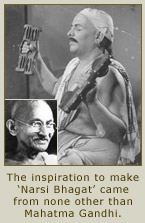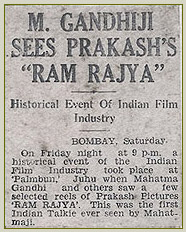- Home
- The Beginning
- Spotlight
- Tours
- Honours
- The End
Phase Two
From 1940 onwards, Vijay Bhatt produced and directed a series of outstanding films which depict and glorify our ancient culture and philosophy on one hand and socially relevant and nation building thoughts on the other. The first among those was a bilingual titled 'Narsi Bhagat' in Hindi and 'Narsi Mehta' in Gujarati.  Made in 1940, it was based on the life of the great poet saint of Gujarat, whose 'Vaishnav jan to tene re kahiye je...' was one of the favorite bhajans of Mahatma Gandhi. In fact, the suggestion to make the film had come from the Mahatma himself. On a visit to Valsad, Vijay Bhatt and his friends went to seek Gandhiji's 'darshan'. They approached him during his morning walk and sought his blessings. In a brief talk that Bhatt managed with the Mahatma, he was asked, "What are you doing?" "I make films", said Bhatt. "Have you thought about making a film on Narsi Mehta?" was the second and the only other question. "I will try to make it Bapuji" said Bhatt.
Made in 1940, it was based on the life of the great poet saint of Gujarat, whose 'Vaishnav jan to tene re kahiye je...' was one of the favorite bhajans of Mahatma Gandhi. In fact, the suggestion to make the film had come from the Mahatma himself. On a visit to Valsad, Vijay Bhatt and his friends went to seek Gandhiji's 'darshan'. They approached him during his morning walk and sought his blessings. In a brief talk that Bhatt managed with the Mahatma, he was asked, "What are you doing?" "I make films", said Bhatt. "Have you thought about making a film on Narsi Mehta?" was the second and the only other question. "I will try to make it Bapuji" said Bhatt.
That was it. The inspired film maker immediately got down to working on the script. This was also the time when Prabhat Pictures had successfully made the life of the saint Tukaram into a memorable film - 'Sant Tukaram'. And Vijay Bhatt signed on the lead player from Prabhat's film, Vishnupant Pagnis, to essay the role of Narsi Mehta. He also signed on another noted Maharashtrian actress, Durga Khote to play the saint's wife. The bilingual was very well received throughout India and even celebrated silver jubilee at many places. Bhatt's only regret was that Gandhiji could not see the film.
Before 'Ram Rajya', a Hindi-Marathi bilingual, Vijay Bhatt had produced and directed another Hindi-Marathi bilingual, 'Bharat Milap' and 'Bharat Bhet' in Marathi. It was based on a touching episode from Ramayana after Ram was banished from Ayodhya and it highlighted the love the brothers had for each other.
 Dr. Radhakrishnan had premiered 'Bharat Milap' at Majestic Cinema, Bombay. Though Radhkrishnan had very little time at his disposal, he liked the film so much that he sat through till the end. In Calcutta, the premier was inaugurated by Dr. B.C. Roy who was then a minister in the Bengal Cabinet. The film was a great success and celebrated silver jubilees everywhere. In Bombay, celebrations at various places were presided over by prominent dignitaries like Dr. K.M. Munshi, Shri Pranlal Devkaran Nanji, N.C. Kelkar and the late Shri Malvankar. Vijay Bhatt was felicitated at numerous functions by various organizations and presented with trophies and platters.
Dr. Radhakrishnan had premiered 'Bharat Milap' at Majestic Cinema, Bombay. Though Radhkrishnan had very little time at his disposal, he liked the film so much that he sat through till the end. In Calcutta, the premier was inaugurated by Dr. B.C. Roy who was then a minister in the Bengal Cabinet. The film was a great success and celebrated silver jubilees everywhere. In Bombay, celebrations at various places were presided over by prominent dignitaries like Dr. K.M. Munshi, Shri Pranlal Devkaran Nanji, N.C. Kelkar and the late Shri Malvankar. Vijay Bhatt was felicitated at numerous functions by various organizations and presented with trophies and platters.
His next venture, 'Ram Rajya', also based on the Ramayana, was even more ambitious and won him great honors and adulation throughout the country. It was eulogized as a torch bearer of our glorious past and cultural heritage. The film ran for 100 weeks in one theater alone in Bombay and 50 weeks at various theaters elsewhere. The dignitaries who praised and paid tributes to Shri Vijay Bhatt were Dr. K.M. Munshi, Justice Chagla, Pt. Madan Mohan Malviya, Goswami Ganesh Chatterjee, Smt. Aparna Das, Justice Bhagwati and many other distinguished citizens all over the country. A special committee of citizens was formed under the chairmanship of late Shri Pranlal Devkaran Nanji to felicitate the Ram Rajya unit and a number of public addresses were given to Mr. Bhatt.
throughout the country. It was eulogized as a torch bearer of our glorious past and cultural heritage. The film ran for 100 weeks in one theater alone in Bombay and 50 weeks at various theaters elsewhere. The dignitaries who praised and paid tributes to Shri Vijay Bhatt were Dr. K.M. Munshi, Justice Chagla, Pt. Madan Mohan Malviya, Goswami Ganesh Chatterjee, Smt. Aparna Das, Justice Bhagwati and many other distinguished citizens all over the country. A special committee of citizens was formed under the chairmanship of late Shri Pranlal Devkaran Nanji to felicitate the Ram Rajya unit and a number of public addresses were given to Mr. Bhatt.
However, what makes this film truly unique is not merely the human treatment given by Bhatt to a mythological tale. It is the  fact that it was the only film to have been seen by Mahatma Gandhi in his lifetime. 'Ram Rajya' was shown to Mahatma Gandhi in 1945, when he was convalescing at Juhu. His secretary, Smt. Sushila Nayar, had given Vijay Bhatt only 40 minutes for "Bapu" to see the film. But the movie so engrossed him, that Mahatma Gandhi saw it for over 90 minutes, uninterrupted. Since it was a 'moun' day for him, he gave Bhatt a pat on the back at the end, to show his appreciation. This remained for Bhatt, one of the greatest events of his life. He never won the Dadasaheb Phalke award, despite being nominated year after year. But he often used to say : "The pat on the back by Gandhiji is more precious to me than any award that can be obtained by lobbying the corridors of power."
fact that it was the only film to have been seen by Mahatma Gandhi in his lifetime. 'Ram Rajya' was shown to Mahatma Gandhi in 1945, when he was convalescing at Juhu. His secretary, Smt. Sushila Nayar, had given Vijay Bhatt only 40 minutes for "Bapu" to see the film. But the movie so engrossed him, that Mahatma Gandhi saw it for over 90 minutes, uninterrupted. Since it was a 'moun' day for him, he gave Bhatt a pat on the back at the end, to show his appreciation. This remained for Bhatt, one of the greatest events of his life. He never won the Dadasaheb Phalke award, despite being nominated year after year. But he often used to say : "The pat on the back by Gandhiji is more precious to me than any award that can be obtained by lobbying the corridors of power."
Vijay Bhatt then went on to produce and direct a grand historical, 'Vikramaditya' (1945) at the instance of the Vikram Bimillenium Committee, which wanted the film to be a part of the celebration of the 2000 years of Vikram era. Focusing on the historic aspects and abjuring myths and legends, the film maker portrayed the ancient monarch as a savior of the nation from subjugation. Prithviraj Kapoor, who was at the height of his career then, enacted the title role. His son, Raj Kapoor, who was still a teenager at that time, often came to the studio with a tiffin carrier, with lunch from home for his father. "His inquisitiveness was remarkable", recalled Vijay Bhatt. "He always met me with respect even when he himself became an outstanding actor and film maker," he added. "Respect for elders and seniors is a remarkable trait among the Kapoors."
In 1947, Bhatt toured the US with the twin objective of attending the premiere of 'Ram Rajya' over there and exploring co-production possibilities of a film on the life of Buddha. The script of Buddha was written in English by the late Shri Harindranath Chattopadhyay. He also carried with him the prints of 'Bharat Milap' and 'Vikramaditya' for private screenings.
 Going round the famous studios of Hollywood, Vijubhai met a number of stars and filmmakers. These included then fifteen-year old Elizabeth Taylor, swimming beauty Esther Williams, funster Eddie Cantor and the future President of America, Ronald Reagan, who was shooting for 'Voice Of The Turtle' and the legendary Cecil B. De Mille.
Going round the famous studios of Hollywood, Vijubhai met a number of stars and filmmakers. These included then fifteen-year old Elizabeth Taylor, swimming beauty Esther Williams, funster Eddie Cantor and the future President of America, Ronald Reagan, who was shooting for 'Voice Of The Turtle' and the legendary Cecil B. De Mille.
Vijay Bhatt even visited the Soviet Union in 1954 as a member of the first Indian film delegation. He had taken with him his film, 'Baiju Bawra', which was a great musical hit with exquisite "raaga" based songs.
Phase One | Phase Two | Phase Three